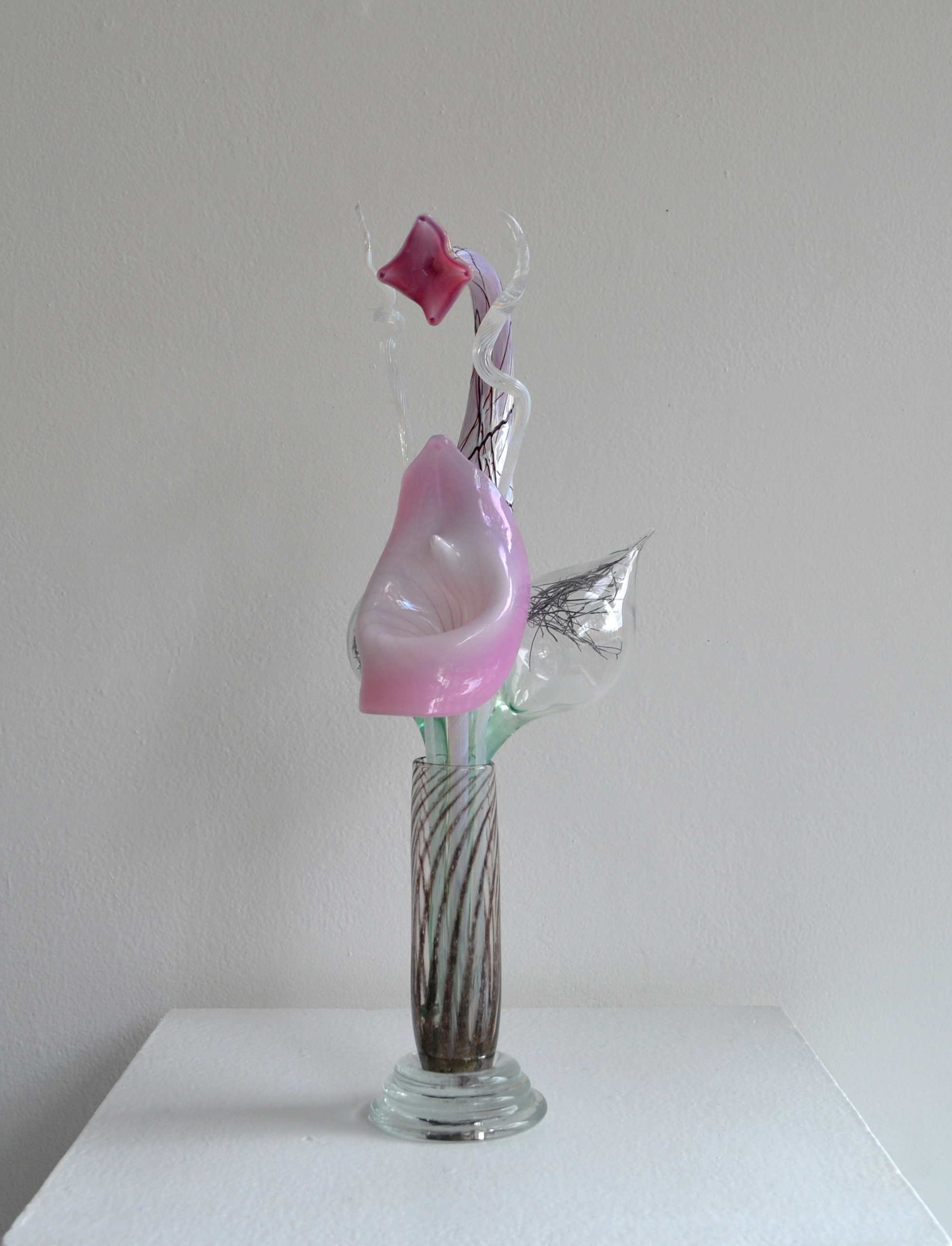Celebration, 35th Anniversary Exhibition IV
Langley created an astonishingly rich body of work while restricting himself to a few forms: single flowers that rest on a table, full-scale floral bouquets, goblets and stemware, and flower bowls. These flowers resonate with emotion and personality. Some are whimsical, cartoon-like in plasticity of their forms: petals droop in sorrow, stems reach up and out, stretching as if waking from a deep sleep. The arrangements are voluptuous and sensuous, inviting a touch despite their fragility. Langleys technical mastery of color adds to the beauty of his forms. Layers of color allow the glass flowers to radiate from within, such as a menacing , basically black composition is balanced by a delicate and subtle pink, “feminine”flower.
Cam stated, “Initially I was influenced by Louis Comfort Tiffany and turn of the century glassblowers who created Art Nouveau forms”… “moving through different periods of design, it seems that one form has transformed into another, helping me move from vase to flower to stemmed flowers.” His tradition of giving his wife flowers for their anniversary evolved into his primary production interest as a studio artist. He was known for his fantasy flowers as well as skillfully interpreting native southern plants in glass
Lana A Burgess, Ph.D.
Clinical Professor and Curator
McKissick Museum University of South Carolina
George Campbell “Cam” Langley earned a BA in Civil Engineering from Virginia Tech in 1970. After graduating, he worked for the Virginia Department of Health and at his father’s firm, Langley, McDonald & Overman Consulting Engineers. He took a year off to work as a crewman on a sailboat in the Caribbean and realized engineering was not his true path. After reading a book written by Harvey Littleton, who was known as the “father of the modern glass movement”, he contacted Harvey unaware of Littleton’s eminence. Littleton invited him to see his glass studio and suggested Cam attend The Penland School of Crafts in North Carolina. The three week glass blowing workshop at Penland, stimulated his desire to become a glassblower- as he sold the first pieces he made. He once said he “wanted everyone in America to own a piece of his work” whether bought in a gallery or off the back of his pick-up truck. He continued his education enrolling at the University of Wisconsin, Madison. He received a National Endowment for the Arts Apprentice Fellowship and spent 4 years as a non-degree student. He acquired precise glassblowing techniques there and refined his imagery using experimental forms from nature as inspiration.
Langley moved to Birmingham, Alabama in 1982, where he married fellow artist Janice Kluge, and set up his hot glass studio which for many years the only facility of its kind in the state. Peter Baldaia, Director of the Huntsville Museum of Art, stated , “As a participant in the American Studio Art Glass movement … over a 30-year period, Birmingham artist Cam Langley became a respected figure in Alabama art circles known for his signature fantasy flowers and elegant stemware in blown and hot worked glass.” In 2007, Cam and Janice established The Kluge/Langley Endowed Scholarship for the UAB Department of Art and Art History.
Langley’s work is recognized nationally and internationally. He participated in numerous art fairs including several American Craft Council (ACC) art fairs, the Virginia Beach Boardwalk Art Show and Coconut Grove, Miami, FL. His glass was represented by more than 50 galleries and featured in many private and public collections; including The Frederick Weisman Art Foundation in Los Angeles California, Southern Progress Corporation, and commissioned gifts for the former President of the Czech Republic and German Ambassador to the US. He was commissioned for a special bouquet of red flowers for the Coca Cola executive offices, and Walter Chrysler personally selected his work for the renowned glass collection of the Chrysler Museum, Norfolk, Va. His work has been collected by the New Orleans Museum of Art, the Huntsville and Birmingham Museum of Art and the Montgomery Museum. Langley’s work is in countless corporate and personal collections.
Space One Eleven Involvement: Beauties and Beasts: Issues of Aesthetics 1992
